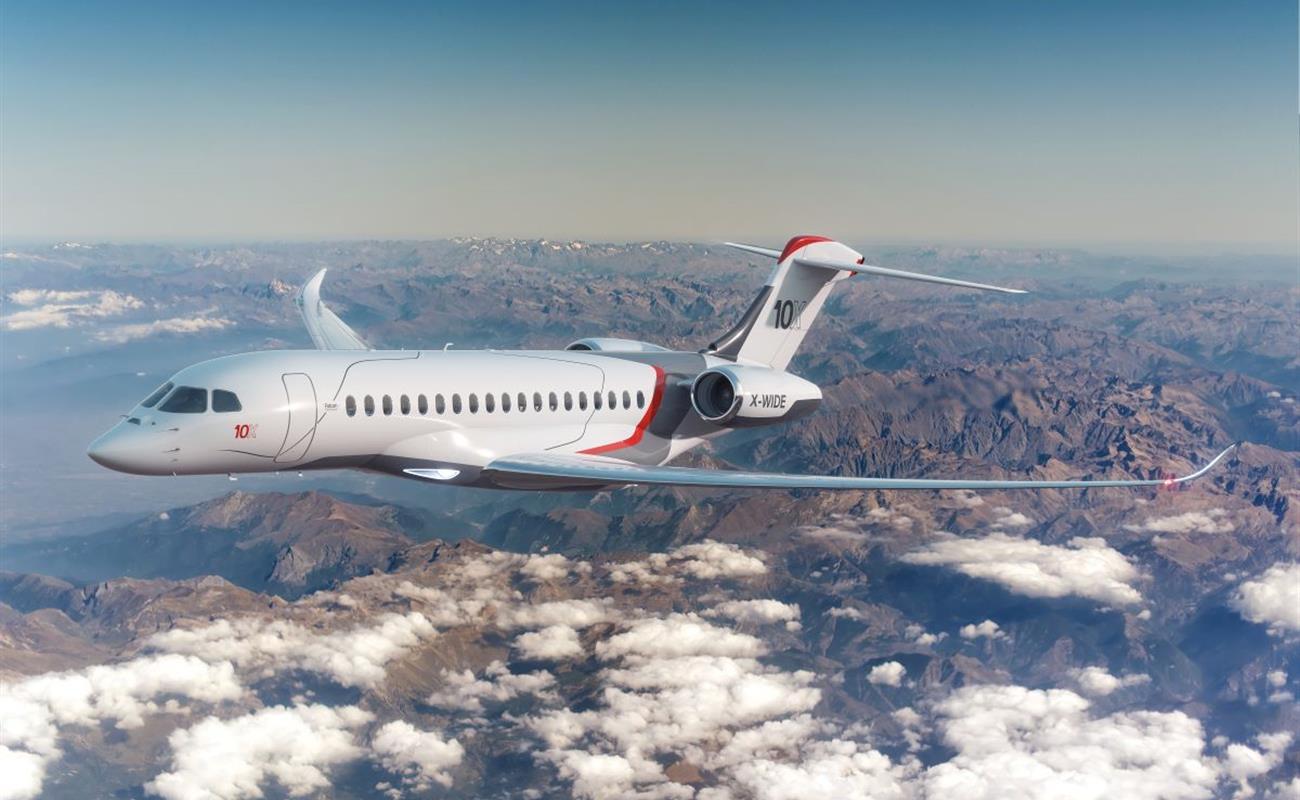
A computer-generated rendering of Dassault’s new Falcon 10X ultra-long-range business jet. (Dassault Aviation)
Dassault used a combination of augmented and virtual reality to unveil their new long-range business jet, Falcon 10X, during a May 6 program launch ceremony broadcasted from their hangar at Le Bourget.
Falcon 10X is Dassault’s direct competitor to the newest large cabin jets from Gulfstream and Bombardier, the G700 and Global 7500. With a range of 7,500 nautical miles, it will become the first Dassault business jet to be powered by Rolls Royce engines. Dassault executives and pilots gave an overview of the jet’s new design features using virtual reality to show what the real 10X will look like when it enters service, which the French aerospace and defense manufacturer expects to occur by the end of 2025.
“The 10X will be more than just another big step forward in business aviation. It will be absolutely the best business jet available in the ultra-long-range category and will remain so for a long time,” Dassault Chairman and CEO Eric Trappier said in a press release announcing the 10X.
Honeywell Aerospace is providing a next-generation version of their Epic flight deck for the 10X. Stevan Slijepcevic, president of the electronic solutions division at Honeywell Aerospace told Avionics International that the touchscreen user interface for Epic on the 10X was developed with a new avionics design language system designed to support touch-based interactions directly on the display screens and the new touchpad cursor control device.
“Falcon 10X features eight touch-enabled high definition displays with sharp contrast; which provide clearer display of visual information in high and low light conditions. Flexible window application layout presets based on Phases of Flight or ability to create customized application layout configurations based on personal preferences, which can be saved as presets,” Slijepcevic wrote in an emailed statement. “The Smart Display Units (SDUs) support quicker data entry, instant insertion of radio frequencies, or queuing up of radio frequencies for future use. They also provide quicker access to information and/or systems—every control is within 2-3 taps/clicks.”
There is also a new advanced navigation system capable of displaying spherical projections of flight plans on the displays, focused on supporting the longer ranges that the Falcon 10X can fly.
“With long range comes long flight plans. Today’s maps require a lot of panning and map manipulation due to their limits on range depiction. That takes time and increases pilot workload. With the upgrades to INAV (Interactive Navigation), a pilot can now see the entire international flight plan from origin to destination in one view. Zooming in to areas of interest like a waypoint along the flight plan or even your FBO at the destination airport are significantly easier now because of the forward touch display integration,” Slijepcevic said.
On the 10X, the Epic flight deck uses a larger vertical situation display, giving pilots better manipulation of waypoints associated with some of the newer more complex departure and arrival procedures. According to Honeywell, the larger window option to show the VSD can now integrate airspace and weather information that was previously restricted to lateral mapping display applications.

A computer-generated mockup of the flight deck of the new Falcon 10X. “Dual head-up display including FalconEye award-winning [combined vision system] CVS system will be proposed as a primary mean for controlling the aircraft,” Phillipe Duchateau, chief test pilot for Dassault Aviation said during the 10X launch ceremony. (Dassault Aviation)
“One of the features I’m most excited about is Honeywell’s patented vertical graphical flight planning. Honeywell was the first to introduce graphical flight planning on the lateral map with the introduction of Epic and now we extended the same intuitive graphical interaction to the VSD. Pilots will now be able to perform a Vertical Direct To graphically on the VSD waypoint as well as easily insert or amend altitude, speed or time of arrival constraints,” Slijepcevic said.
Another new innovation featured on the Falcon 10X version of Epic is a Single Antenna Radar Altimeter (SARA) that integrates what previously required six separate avionics components into one single unit. The SARA integrates the transmit and receive antennas into one, while also supporting CAT I and II landings . “Radar altimeter installations typically take several hours to mount the two antennas, two cables, tray, and the radar altimeter itself. SARA installation can be completed in 15 minutes and requires a simple eight screws and one connector,” Slijepcevic said.
The 10X will also feature a next-generation version of the digital flight control system on Dassault’s Falcon 6X, 7X and 8X. Among the new features discussed by Dassault’s two test pilots during the 10X launch ceremony, is a new recovery mode that is activated with the touch of a single button. Using the push-button recovery system will return the aircraft back to straight and level flight from any position.
The 10X will also borrow flight control technology already in-service on their Rafale fighter jets with a single power lever smart throttle capable of controlling all thrust management and fly-by-wire aspects of the navigation system. Airbrake and thrust reverser controls have also been included in the smart throttle, and separate controls will allow 10X pilots to control each of its Rolls Royce Pearl engines individually.
There is also enough room in the cockpit for a fully lie-flat seat, where—future regulation permitting—one pilot would be able to rest while the other is flying.

With a cabin volume of 2,780 cubic feet (79 cubic meters), the 10X offers the largest cabin interior of any purpose-built business jet. It is almost 8 inches (20 cm) wider than its competitors, according to Dassault.
“We have set the bar for our new Falcon incredibly high,” Trappier said. “But I can confidently say that we have put this aircraft at the top of the market.”